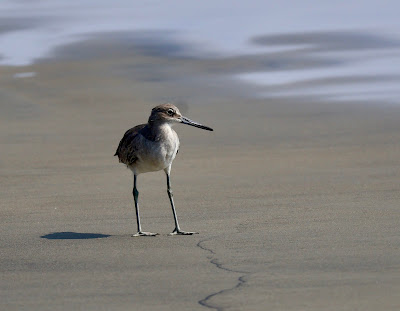I really like oystercatchers. They are so unique appearing with their long, blunt orange bill and dramatic red eye. On a previous trip to coastal California many years ago, I did find a Black Oystercatcher (Haemotopus bachmani) along a rocky part of the La Jolla coastline. On this trip, whenever I was near a rocky coastline (only twice), I was on a search for Black Oystercatcher - ultimately unsuccessful.
On my final day in California, in the late afternoon I arrived at the beach in Coronado. The first thing I saw was a gigantic surf break of large, black rocks and headed straight for it. I started at one end and walked slowly along the rocks seeing nothing except the Brown Pelicans feeding in the surf beyond the rocks. Then three little birds pecking around a large, flat-top boulder appeared. Ah, that's what I want to see. I wasn't wearing the correct shoes for climbing but I managed. I didn't know what I was seeing. At first I thought the bird in the photos below was a resting seabird - oh, I don't know - like some little petrel or something. Then the bird got up and moved. I saw the large amount of white and thought, no, this is a Surfbird (Calidris virgata). Surfbird was a life bird for me. Surfbird remained my identification until I got home, downloaded my photos and pulled out Sibley. No, this is a Black Turnstone (Arenaria melanocephala) - also a life bird for me! I'm nearly certain that I had never paid attention to the fact that there even was such a bird as Black Turnstone.
As you can see, my Black Turnstone was very cooperative. There were three altogether. For photos I focused on this one bird.
Below are some of the other birds I saw on this final afternoon.
Brown Pelican (Pelecanus occidentalis)
Preparing to dive.
A threesome. Western Gull, Brown Pelican and no idea what the dark bird flying forward is. Maybe a sea bird of some sort - like a shearwater or a petrel? Something else? It's difficult to get an idea of the size of the bird, but it seems big. Brown Noddy (Anous stolidus) perhaps? But Brown Noddy does not occur in coastal California. A juvenile gull would make sense, but juvenile Western Gull has a black bill and this bird has a yellow bill and, anyway, it doesn't look like a gull to me. The spread v-shaped, white tipped tail should be a clue, but I can't find a match. I have precious little seabird experience to help me with this. (See addendum below).
Flying Willet (Tringa semipalmata)
Above and below: Willets (See narrative below photos).
Diving Osprey (Pandion haliaetus)
Another Willet
Diving Brown Pelican
Juvenile Western Gull (Larus occidentalis). They stood on the beach making their plaintive little begging notes.
On the Coronado beach the only shorebirds I saw were Willets. They were paired up every hundred feet or so. I kept walking hoping to come upon other shorebirds. I saw a darkened area in the sand, the tide was going out, that seemed to have little birds moving around in it and I made a beeline for the spot. Around the same time I heard a whistle blow. I thought, hmmm that's odd, I don't see any lifeguards or swimmers that appear to be in trouble. I kept walking toward my goal. I heard the whistle again. I kept walking. Suddenly, on my left a young woman, a little breathless and dressed in military gear, ran up alongside of me. She smiled and greeted me, "do you have ID?" "Yes, of course." I reached for my bag to remove my wallet. "Military ID?" "No, I don't have military ID, just regular ID." "I'm sorry, you can't be here." I had crossed an invisible line in the sand that took me across to an area reserved exclusively for military personnel. I looked longingly at the specks moving in the area up ahead and feebly said, "I'm only taking pictures of birds." She slowly shook her head back and forth and I turned back to walk the way I had come.
Addendum 09/23/2024: The unidentified bird flying forward in the 10th photo (A threesome ... ) may potentially be a 2nd winter Heermann's Gull (Larus heermanni). I recently had the opportunity to look at this photo on a larger screen than that of my laptop and noted the hint of a white head being present. The overall dark bird with white tipped tail and yellow bill are also good matches. Additionally, there were plenty of Heermann's gulls present on the beach. The spread v-shaped tail bothers me a little, but this may just be an artifact of the flight angle in the photo and is possibly insignificant.




















No comments:
Post a Comment